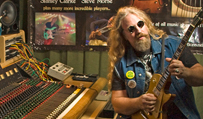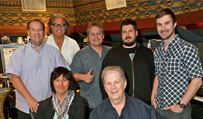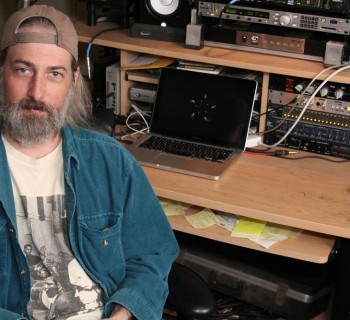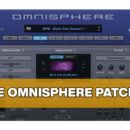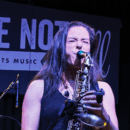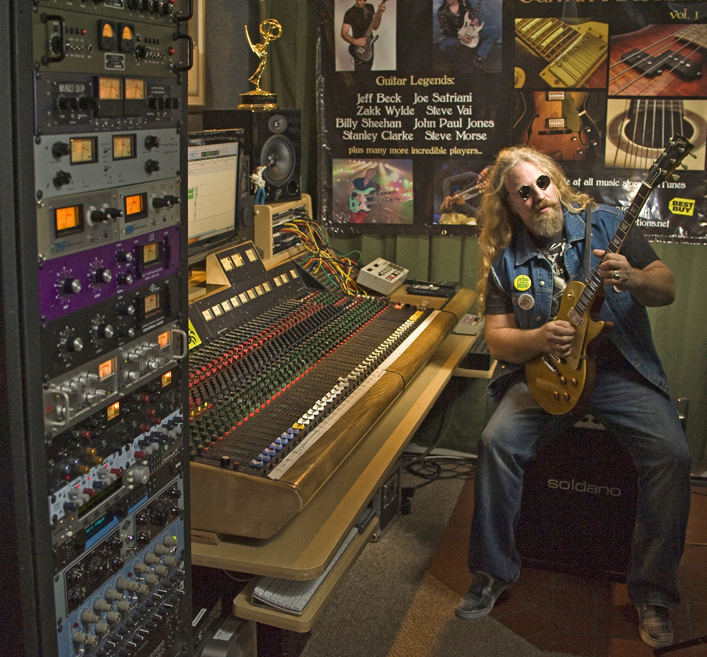 I remember, as an adolescent in the ‘70s, recording guitar parts on my Dad’s Grundig 2-track 1/4-inch reel-to-reel tape machine, using a razor to edit the tape—which I still do today. That’s right. I find it necessary, for certain types of music, to record to 2-inch tape, especially when tracking drums, bass and rhythm guitars.
I remember, as an adolescent in the ‘70s, recording guitar parts on my Dad’s Grundig 2-track 1/4-inch reel-to-reel tape machine, using a razor to edit the tape—which I still do today. That’s right. I find it necessary, for certain types of music, to record to 2-inch tape, especially when tracking drums, bass and rhythm guitars.
But today, of course, all one has to do is buy a computer, Mac or PC, and there are a plethora of digital recording platforms that come complete with tons of music loops to help you create songs. This takes the worry out of the recording process, letting the artist concentrate on the actual music at hand and not so much on the technical aspect of it. But all of this high-tech freedom to create doesn’t mean you can overlook some essential areas.
To help you get better results for your DIY recording projects, here are some tips and tricks that always work for me.
Combine Both the Analog and Digital Worlds
Even with the convenience of using built-in samples and recording everything in the “Box,” I find you need to combine both the analog and the digital worlds. That’s why I mix everything out of Pro Tools or Logic through my analog classic Trident recording console and use physical outboard gear, like Urei 1176, LA-4, and so on.
Though an indie artist does not have to go to that extent, if you want to record guitar I strongly recommend recording it from an amp with a very affordable mic, like a Shure SM57. Direct guitar signals are not very pleasing to listen to and many of the plug-ins have a processed sound.
Before I had a recording studio, I recorded guitar cabinets with a SM57 in my apartment in Los Angeles, I would place the amp in a closet, so as not to disturb the neighbors. To an all-digital song, this brings the track alive with an actual live instrument.
Keep in mind, if you want to change the tone of the instrument then move the mic first before you reach for any of your EQ plug ins. Usually this is the most natural and effective way.
Invest in Tools of the Trade
You would be surprised how many instruments the SM57 can record—everything imaginable. For less than a 100 bucks this is the most versatile microphone a musician can own, being able to record everything from horns to drums. There are also companies like CAD, Nady and Audix that make affordable mic sets for drums as well. Plus, depending on your digital interface you may want to use a mic preamp, which, again, a plethora of companies make from 99 bucks to thousands. One of my favorites is the Universal Audio 610.
But remember you don’t have to break the bank to get pro audio equipment today; there are so many affordable companies that manufacture gear for every price range. Bear in mind, this is a one-time expense for an essential item that you can use for many projects. If you plan on doing recording music for your livelihood, then it is a good investment.
Don’t Drown Under Too Many Tracks
This is an area where I see so many musicians drown themselves. Just because you can have unlimited tracks doesn’t mean you have to use tons of tracks for a song. If the song really calls for many tracks and crossfades, okay, then go ahead. But I still like the track limitation we had in the past—there was no choice but to stop recording take after take—simply because you would run out of tracks. Decisions had to be made when the take was completed so you could then move on.
Believe me, after 20 years doing this, 99.9 percent of times the best takes are usually within the first three; after that you can hear musicians start to wane. I advise you to label every track, such as Bass 1, Bass Chorus, Sax Solo and so on; otherwise during mixdown you’ll waste way too much time searching for the correct tracks to mix. There is nothing worse than having 45 tracks staring at you, unlabeled, for a five-minute song, in which you have to determine how to reconfigure the whole song.
Don’t Crush the Living Essence Out of Your Mix to Make It Loud
Man, when the Waves L2 Processor came out, yes it made everything loud, but destroyed so many mixes just for the sake of loudness! Music has to have some sort of dynamics, not just soaring levels constantly in the red. This is why vinyl has been making a come back in recent years, especially the old recordings, like David Bowie’s Diamond Dogs, Led Zeppelin IV, etc.—those records possess dynamics, no matter how much they rock out. Hell, even the hair bands had dynamics in their mixes.
If you crush the living essence out of your mix and make it loud, you’ll lose all of the tone of the instruments and vocals. But fortunately there is a great, affordable mastering plug-in that doesn’t squash your mix and still keeps it alive: the Slate Digital FG-X. For 200 bucks this plug-in is terrific. It keeps your dynamics in place and still gives you the loudness you need for modern-sounding tracks.
Bottom Line
Today’s musician can be it all: the engineer, producer and artist all in the confines of their own home. So use the technology to your advantage and take your time when recording to get the performances correct. And always be well rehearsed before you hit that red button!
By Brian Tarquin
BRIAN TARQUIN is the winner of multiple Emmy Awards, having established himself as a top-rate TV composer/guitarist. In 2006 SESAC honored him with the Network Television Performance Award. In addition, Tarquin has produced and composed the Guitar Masters series, trading licks with such guitar greats as Leslie West, Steve Morse, Billy Sheehan, Frank Gambale, Andy Timmons, Chris Poland (Megadeth) and Hal Lindes (Dire Straits). For further information, visit http://tvfilmtrax.com.

